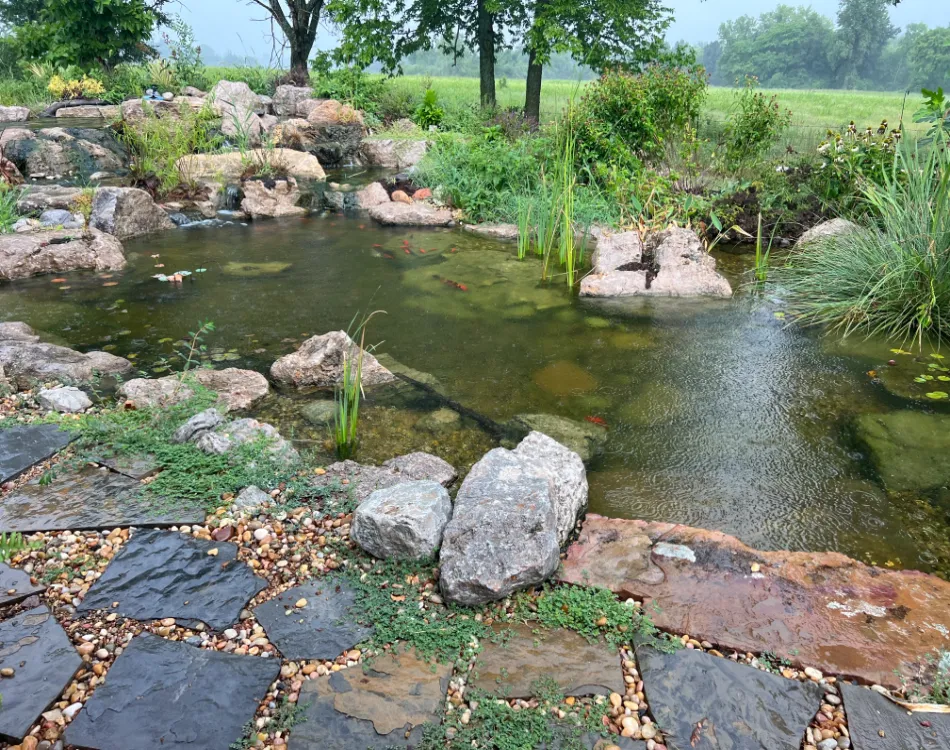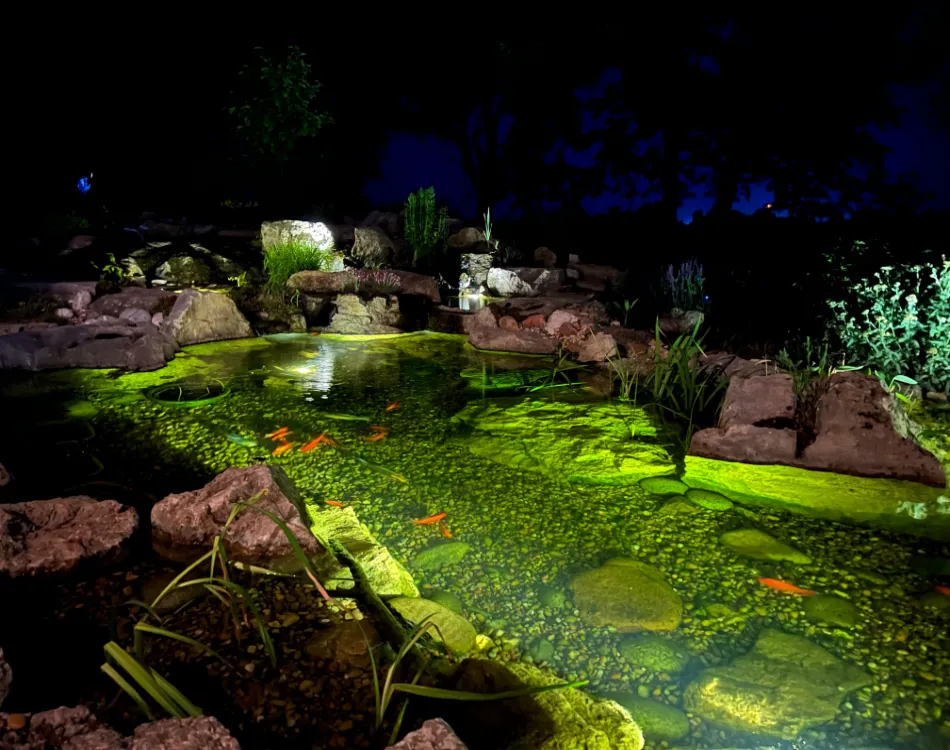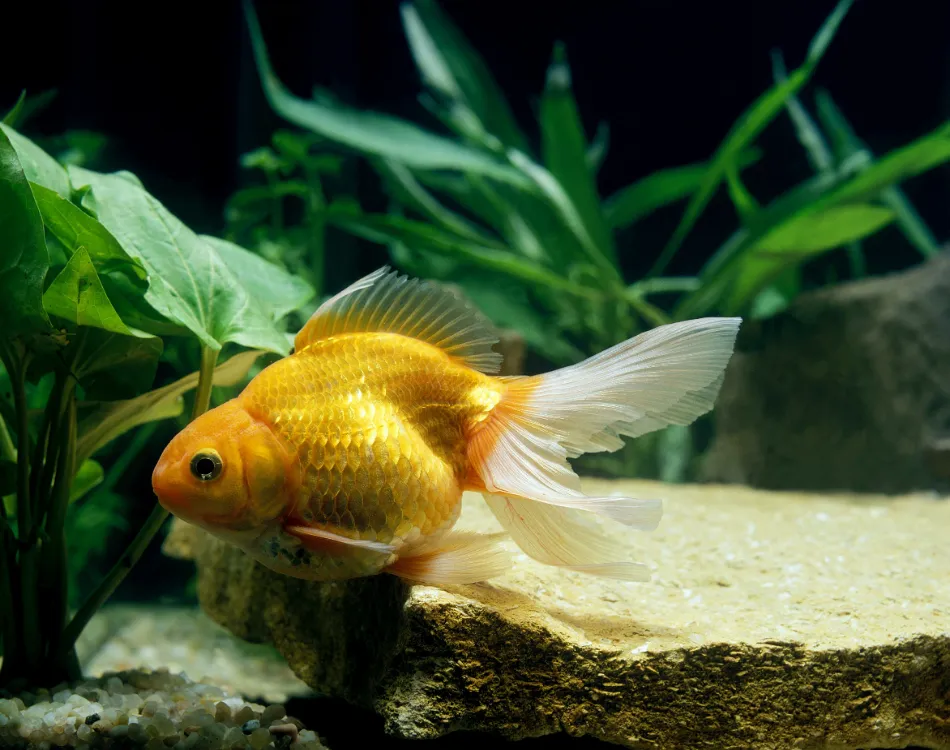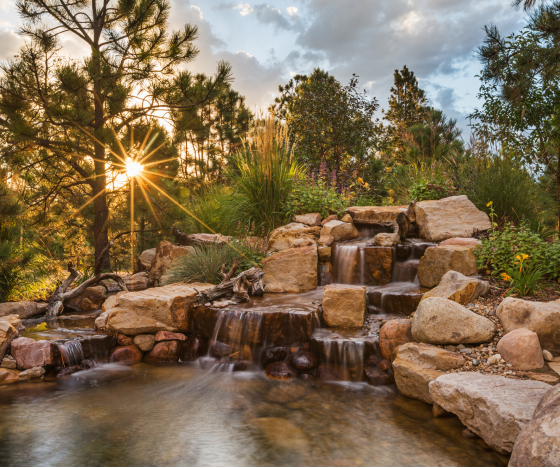 Goldfish are a popular choice for fish pond owners. They’re relatively low maintenance and can add a splash of color to your pond. However, is it possible to keep goldfish in an outdoor pond?
Goldfish are a popular choice for fish pond owners. They’re relatively low maintenance and can add a splash of color to your pond. However, is it possible to keep goldfish in an outdoor pond?
The short answer is yes, but outdoor ponds have their own challenges that must be considered before adding goldfish.
This blog post will explore the requirements for keeping goldfish in an outdoor pond, such as having a professional Kansas City, MI, koi pond construction company handle it. We’ll also offer tips on making your pond environment as safe and healthy as possible for these beautiful fish.
Can Goldfish Live In An Outdoor Pond?
Many people considering stocking their ponds with fish wonder if goldfish can live in an outdoor pond. The simple answer is yes, common goldfish can live 10-15 years in an outdoor pond.
Goldfish Are Hardy
One of the reasons why goldfish are such a popular choice for outdoor ponds is because they’re hardy little creatures. They can tolerate a wide range of water conditions and temperatures, which makes them the perfect pond fish for outdoor ponds. Outdoor ponds, in particular, may experience drastic changes in weather from one day (or season) to the next.
Of course, that doesn’t mean that goldfish don’t have specific needs regarding their aquatic habitat (more on that in a bit).
So while goldfish can live in an outdoor fish pond, there are a few things to keep in mind:
Pond Size
Most experts recommend that outdoor ponds for common goldfish have at least 50 gallons and be at least four feet deep. This will give the goldfish enough room to swim and explore.
That said, if you plan on keeping goldfish long-term, it’s best to provide them with even more space. While an outdoor goldfish pond can be too small, it can never be too big!
When it comes to goldfish, there are several reasons why a larger fish pond is more beneficial:
Larger Ponds Handle Fish Waste Better
It’s important to note that goldfish produce a lot of waste, so a larger pond will be able to accommodate more goldfish while still remaining clean and healthy.
Larger Ponds Have More Oxygenated Water
Goldfish are cold-water fish, so they need access to oxygenated water. A larger fish pond will have more surface area, which means more oxygen will be able to dissolve into the water.
Larger Ponds Are Better In The Winter
If you live in an area with cold winters, you’ll need a larger pond so your goldfish can survive the winter months.
Ultimately, the size of your goldfish pond will depend on the number of goldfish and your climate. If you have a lot of goldfish, you’ll also need a larger pond to accommodate them. But goldfish generally don’t require a vast pond to stay healthy and happy.
Filter And Pump
While goldfish can technically survive without a filter or pump in an outdoor pond, it is not recommended.
Is Filtration Necessary For An Outdoor Goldfish Pond?
Goldfish are relatively low-maintenance pets, and they can thrive in a wide range of environments. However, they produce a fair amount of waste, so a pond with a large goldfish population may require some filtration.
Here are a couple of reasons why there are many koi pond filters options recommended for outdoor goldfish ponds:
- A goldfish pond should have a clear, circulating water source to ensure the goldfish stay healthy. A filter will help to keep the water clean and free of harmful bacteria, ammonia, and nitrates
- Filters can also help to aerate the water, making it healthier for goldfish and plants alike
- Goldfish are more likely to fall prey to disease and parasites without a filter. So while they may be able to survive without one, it is not worth the risk
Investing in a good filter can help ensure that your goldfish pond remains healthy and beautiful for years to come. If you are interested in keeping your pond clean the natural way, be sure to check out our guide to natural pond filtration.
Is A Pump Necessary For An Outdoor Goldfish Pond?
The answer is: it depends. When it comes to goldfish ponds, pumps serve multiple important purposes.
- First and foremost, they help to keep the water circulating. This is important because goldfish are prone to various diseases caused by stagnant water
- Circulating water is also oxygenated water, which is essential for the health of goldfish
- Goldfish prefer slightly cooler water temperatures, so a pond in a spot with lots of sunlight may need to be outfitted with a pump. A pump will circulate the water and help prevent it from getting too warm. In general, goldfish should be kept in water between 65 and 75 degrees Fahrenheit. However, they can withstand colder temperatures as long as the fish pond doesn’t freeze
- Pumps also help to keep the pond clean by preventing debris from settling on the bottom
- Lastly, pumps can also be used to create a waterfall or other feature in your goldfish pond. This adds visual interest and provides a place for your goldfish to play
Ultimately, the best way to determine whether or not your goldfish pond needs a filter and pump is to consult with a local pond expert. They can assess your specific situation and make recommendations accordingly.
Sun
Another factor to remember when stocking an outdoor pond with goldfish is the amount of sunlight the site receives.
Goldfish are cold-water fish, so the pond should be located in an area with at least partial sun. This will help keep the water warm enough for the goldfish to thrive and allow your pond plants to grow.
Plants And Rocks
Goldfish prefer a pond with plenty of plants and rocks. There are several reasons for this, so let’s start by looking at the benefits of plants.
Why Plants Are Beneficial For An Outdoor Goldfish Pond
- Plants help to keep the water clean by absorbing contaminants and providing oxygen for the goldfish to breathe
- Plants provide hiding places for goldfish so they can hide from predators such as birds, raccoons, and house cats
- Plants help to regulate water temperature, providing shelter from the heat in summer and insulating against the cold in winter
- Plants add beauty and interest to a goldfish pond, making it a more enjoyable place to spend time. Goldfish love to nibble on plants, so having a few in the pond will help keep them happy and healthy
So if you’re thinking about adding a healthy goldfish pond to your outdoor space, be sure to include plenty of plants!
Why Rocks Are Beneficial For An Outdoor Goldfish Pond
- Rocks provide essential hiding places for pond fish and other aquatic creatures and shelter from predators
- Rocks also help to regulate water temperature and can even improve water quality by promoting the growth of beneficial bacteria
- Rocks give the pond a more aesthetically pleasing appearance
For all these reasons, incorporating rocks into your goldfish pond is not only aesthetically pleasing but also practical.
Temperature
Temperature is another crucial factor when considering stocking an outdoor pond with common goldfish.
Optimal Temperature Range For Goldfish
Goldfish are cold-water fish and require water temperatures between 65 and 75 degrees Fahrenheit to thrive. Goldfish are most active at temperatures between 50 and 68 degrees Fahrenheit.
In warmer climates, goldfish may be able to survive in garden ponds with water temperatures up to 80 degrees. Still, they will be less active and more susceptible to disease.
In cooler climates, goldfish may be able to survive in ponds with water temperatures lower than 50 degrees. However, they will again be less active and more susceptible to disease.
Selecting An Optimal Location for Temperature
As a result, it is essential to choose a location for your goldfish pond that will allow the water to stay within the desired temperature range.
For most people, this means selecting a site that is not entirely covered in the shade but is also not exposed to full sun. This is why it is vital to choose a location for your goldfish pond that will provide the desired temperature range.
Pond Heaters And Aerators For Temperature Control
Suppose your outdoor goldfish pond is not in an optimal area. In that case, you may need to take steps to regulate the water temperature. Installing a pond heater will help maintain the ideal water temperature for goldfish in cold climates.
If you live in an area with freezing winters, you will need to take additional steps to protect your goldfish pond from the cold (more on that later).
For warmer climates, an aerator will help cool the water temperature. Remember that goldfish also need to be acclimated to the temperature of the water before they are added to the pond.
By creating a comfortable environment for your goldfish, you can ensure that they will remain healthy and happy for years to come.
What Is The Best Pond For A Goldfish?
 If you’re considering getting goldfish, you may wonder what the best type of pond is for them. The truth is goldfish are actually quite adaptable and can do well in a variety of different pond types.
If you’re considering getting goldfish, you may wonder what the best type of pond is for them. The truth is goldfish are actually quite adaptable and can do well in a variety of different pond types.
Pond Types
Ponds can be either above-ground or in-ground. Above-ground ponds are usually easier to install and maintain, but they are not as durable as in-ground ponds.
In-ground ponds can be made from concrete, fiberglass, or liner materials and incorporated into your yard better since they are ground level.
Both above-ground and in-ground ponds can easily sustain a goldfish population.
Pond Shapes And Sizes
Ponds come in all shapes and sizes, so the best strategy is to choose one that fits your space and needs. Small ponds are perfect for yards with limited space, while large ponds look best in outdoor living areas with ample space.
As previously noted, most experts recommend a pond at least 50 gallons in volume and at least four feet deep for goldfish. However, this is a general recommendation and not a hard and fast rule.
A general rule is that you can stock one goldfish per 10 gallons of water. However, this number will vary depending on the size and type of goldfish you are keeping.
For example, fancy goldfish tend to grow larger and produce more waste than other types of goldfish, so they should be kept at a rate of one fish per 20-30 gallons.
It’s also important to consider the depth of your pond when stocking goldfish. Ponds that are shallower than four feet deep should be stocked at a lower density to ensure that the fish have enough oxygen.
Ultimately, the best way to determine how many goldfish you can keep in your pond is to consult with a local fish expert.
What Kind Of Water Do Goldfish Need?
 Freshwater Requirements
Freshwater Requirements
Goldfish are freshwater fish, so they can’t survive in saltwater or brackish water. If you use tap water to fill your pond, you should remove the chlorine first. This can be done by adding a de-chlorinator or simply letting the water sit out for 24 hours, so the chlorine evaporates.
Water Cleanliness
One of the most essential things for goldfish is water cleanliness. A goldfish pond should be regularly cleaned to remove debris and waste that can build up and cause problems for the fish.
There are a few different ways to clean a goldfish pond, but one of the most effective is to use a goldfish pond vacuum. This vacuum will remove all of the debris and waste from the bottom of the pond, leaving the water clean and clear.
Goldfish are also susceptible to diseases, so it is crucial to keep their environment clean to help prevent these diseases from spreading. In addition to regular cleaning, goldfish ponds should be equipped with a goldfish pond filter to remove any harmful chemicals or toxins that could harm the fish.
Water Level
One of the most critical factors in goldfish care is water level. Goldfish are susceptible to oxygen deprivation, and a low water level can make it challenging to get the oxygen they need to breathe.
A low water level can also lead to increased stress and disease risk. As a result, it is important to maintain a consistent water level in an outdoor goldfish pond.
A simple way to do this is to install a pond liner that extends several inches above the waterline. This will help prevent evaporation and give you some leeway if the water level drops for any reason.
Oxygen Levels
Goldfish require dissolved oxygen to breathe and are susceptible to low oxygen levels. In warm weather, the demand for oxygen increases, and ponds can quickly become depleted of oxygen. As a result, goldfish may suffer from stress or even die.
There are a few simple steps you can take to ensure that your goldfish pond water has adequate oxygen levels:
- Add aquatic plants to your pond. Plants release oxygen into the water through their leaves and help remove carbon dioxide and other pollutants
- Avoid overstocking your pond with goldfish. More fish require more oxygen, so it’s crucial to maintain a healthy balance
- Consider aerating your pond with a pump or waterfall. This will help to circulate the water and keep oxygen levels high
By taking these steps, you can create safe and healthy water for your goldfish to thrive.
Caring For An Outdoor Goldfish Pond
 Goldfish ponds are a beautiful and relaxing addition to any backyard. Still, they require special care to keep them healthy and functioning correctly.
Goldfish ponds are a beautiful and relaxing addition to any backyard. Still, they require special care to keep them healthy and functioning correctly.
Regular Maintenance
Goldfish ponds require regular maintenance to keep them clean and functioning correctly. This includes regularly removing debris, cleaning the filter, and adding fresh water due to evaporation.
A dirty pond can lead to algae growth, which can deplete the oxygen levels in the water and cause problems for your goldfish. Aim to clean your pond at least once a month or as needed to keep it looking its best.
Feeding Your Goldfish
You should feed your goldfish pellets or flakes explicitly designed for goldfish. You can supplement your goldfish’s diet with live or frozen foods, such as brine shrimp or bloodworms.
It’s important to only feed your goldfish as much as they can eat in one sitting. Otherwise, the uneaten food will sink to the bottom of the pond and decompose, introducing harmful bacteria into the water.
Adding New Goldfish
When adding fish to your pond, be sure to acclimate them slowly by floating the bag they came in near the water’s surface for about 30 minutes before releasing them into the pond. This will prevent shock and help them adjust to their new surroundings.
Winterizing A Goldfish Pond
Goldfish are cold-water fish, so they can’t survive in garden ponds that completely freeze over in the winter. So winterizing a pond is crucial if you have fish in it. If you plan to let your pond entirely freeze in the winter, you must bring your goldfish indoors.
Most types of goldfish can survive in an outdoor pond in winter, but you must provide an air hole. The best way to do this is to use a pond heater to keep part of the water’s surface from icing over.
Goldfish will typically hibernate in the deeper section of the pond since it’s warmer. If you have a pump at the pond’s bottom, you should turn it off. Otherwise, it will cool the entire pond since it will circulate everything.
With proper care, goldfish ponds can be a beautiful and low-maintenance addition to any backyard.
How To Keep Your Goldfish Healthy In An Outdoor Pond
 Goldfish are a popular choice for outdoor ponds because they’re relatively low-maintenance and hardy creatures. However, goldfish have specific needs that must be met to thrive in their new home.
Goldfish are a popular choice for outdoor ponds because they’re relatively low-maintenance and hardy creatures. However, goldfish have specific needs that must be met to thrive in their new home.
Here are a few tips on how to keep your goldfish healthy in an outdoor pond:
- Goldfish proliferate quickly, so a small pond will soon become cramped and stressful for them. So make sure the pond is large enough to accommodate the size and number of goldfish you plan to keep
- Goldfish need plenty of oxygen, so make sure your pond is adequately aerated. A simple way to do this is to add an aerator or pump
- Goldfish are cold-blooded creatures, so they need some heat source to stay healthy. This can be in the form of a pond heater or simply warmth from sunlight
- Goldfish are sensitive to changes in temperature, so it’s important to acclimate them slowly if you’re moving them to a new pond
- Goldfish are active fish, so you’ll need to provide them with good quality goldfish food that contains all the nutrients they need. You may also want to supplement their diet with live plants and insects
- Goldfish are prone to overeating, which can lead to health problems. A little food goes a long way, so only give them as much as they can eat in a couple of minutes
- Goldfish are prey animals, so they feel safer when they have somewhere to hide. Provide plenty of hiding places and plants for them to shelter in
- Goldfish are sensitive to ammonia and nitrate build-up in the water. Keep the water clean by adding a filtration system and regularly testing the pH levels to maintain optimal water conditions
Following these simple tips, you can ensure that your goldfish stay healthy and happy in their new outdoor home!
Gradex Can Build Your Outdoor Goldfish Pond
Outdoor goldfish ponds can be a fun and easy way to add some life to your yard, but it’s important to remember that they require maintenance. However, with a bit of planning, you can easily add some beautiful golden friends to your backyard oasis.
Choose the right location, provide plenty of sunlight, and keep the pond clean. Following these tips can keep your goldfish healthy and happy in their outdoor home.
Have questions about setting up or caring for your outdoor goldfish pond? Fill out our contact form today, and one of our experts will be in touch soon!



